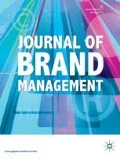Abstract
Luxury is neither a product, an object, a service nor is it a concept or a lifestyle. It is an identity, a philosophy and a culture. As a business sector and management discipline, these characteristics signify the presence of challenges in the integration of luxury branding within the Internet and digital environment and the requirement of intricate strategies to overcome them. Recent publications have raised the issues of the compatibility of luxury and the Internet, the suitability of luxury goods in the virtual environment and strategic approaches to maximising a luxury brand's presence online. Others have indicated that the Internet is a ‘dilemma’ that luxury requires to overcome through avoiding e-Commerce, whereas other literature have suggested that the Internet is purely a channel of communications for luxury brands. The question of the state of luxury in the digital context, however, remains largely unexplored, particularly with regards to the particularities of luxury management, which have posed a challenge in adopting digital technologies in the sector over the past two decades. Until recently, the luxury industry showed low commitment towards integrating advanced Internet technologies and its accompanying interactive and digital tools in the sector's marketing and overall business strategies. They also seemed to be pushed to be present and conduct business on the Internet as a result of evolving consumer needs and expectations. Notable international brands such as Versace and Prada did not have corporate websites until 2005 and 2007, respectively. The economic as well as consumer societies have also expressed bewilderment at the slowness of the luxury industry in establishing an online presence in comparison to other sectors. These parties have been right to question this crucial issue particularly since the Internet has become an indispensable channel of modern business. As an industry that is known for innovation, avant-gardism and creativity, it may not be apparent why luxury brands and digital technology have been perceived as incompatible since the advent of the Internet and digital communications technology. However, as with every case of reverse human behaviour, this may be explained through the examination of the very core of luxury. This paper examines the core and scope of luxury as a business disciple, particularly in the dimension of branding within the digital context. It investigates the true nature of luxury as a current management science and identifies its key drivers and their scope of integration within the Internet environment. This paper has been adapted from a section of the forthcoming book, Luxury Online.
Similar content being viewed by others
References
Okonkwo, U. (2007) Luxury Fashion Branding. London: Palgrave Macmillan.
Kapferer, J. N. and Bastien, V. (2008) The Luxury Strategy. London: Kogan Page.
Tungate, M. (2005) Fashion Brands. London: Kogan Page.
Luxury Briefing. (March 2006) London: Atlantic Publishing.
Okonkwo, U. (2005) Can the Luxury Brand Atmosphere be Transferred to the Internet? Brandchannel.com.
Amed, I. (2007) How to Reach Second Base Online. London: Financial Times.
Okonkwo, U. (2009) Luxury Online. London: Palgrave.
Berry, C. (1994) The Idea of Luxury. United Kingdom: Cambridge University Press.
Lipovetsky, G. and Roux, E. (2003) Le Luxe Eternel. Paris: Editions Gallimard.
Roux, E. and Floch, J. M. (1996) Gérer l’ingérable: La contradiction interne de toute maison de luxe. Décisions Marketing 9 (September–December): 15–23.
Chaffey et al. (2000) Internet Marketing. Essex: Pearson Education Limited.
Dennis, C., Fenech, T. and Merrilees, B. (2004) E-Retailing. United Kingdom: Routledge.
Harris, L. and Dennis, C. (2002) Marketing the E-Business. United Kingdom: Routledge.
Dior, C. (1957) Dior by Dior: The Autobiography of Christian Dior. United Kingdom: Weidenfeld & Nicolson.
Okonkwo (2008) The Birth of the Modern Luxury Industry, Luxe-Mag.Com.
The Club e-Luxe Quarterly. (2008) Issue 0010. 5-7.
Weber, L. (2007) Marketing to the Social Web. United States: Wiley.
Bialobos, C. (1991) Luxe: le palmarès européer des marques. L’expansion 412 (September): 122–125.
Villacampa, E. (1995) Luxe et magasins popularies. L.S.A. 1238: 50–52.
Sharpe, A. and Banting, K. (2002) Understanding of productivity: An introduction and overview. The Review of Economic Performance and Social Progress 2: 1–28.
Sonimers, M. J. (1991) Marketing & Research Today (Netherlands) (February): 35–43.
Kardon, E. (1992) Consumer Schizophrenia. Planning Review (USA) (July–August): 18–23.
DeMoulins, A. (1993) L’explosion du marché de 1 ‘art’. Problemes économiques: 22–24.
Wikianswers. www.wikianswers.com.
Okonkwo, U. (2004) Redefining the Luxury Concept, BrandChannel.com.
A Small World: www.asmallworld.com.
Further Reading
Bourdieu, P. (1984) Distinction: A Social Judgment of Taste, Translated by R. Nice. Cambridge, MA: Harvard University Press.
Coyler, E. (2007) Luxury Brands Confront Web 2.0, Brandchannel.com.
Holt Douglas, B. (2002) Why do brands cause trouble? A dialectic theory of consumer culture and branding. Journal of Consumer Research 29 (1): 70–90.
Keller, K. (2003) Building, Measuring and Managing Brand Equity. New Jersey: Pearson Education.
Author information
Authors and Affiliations
Corresponding author
Rights and permissions
About this article
Cite this article
Okonkwo, U. Sustaining the luxury brand on the Internet. J Brand Manag 16, 302–310 (2009). https://doi.org/10.1057/bm.2009.2
Received:
Revised:
Published:
Issue Date:
DOI: https://doi.org/10.1057/bm.2009.2




